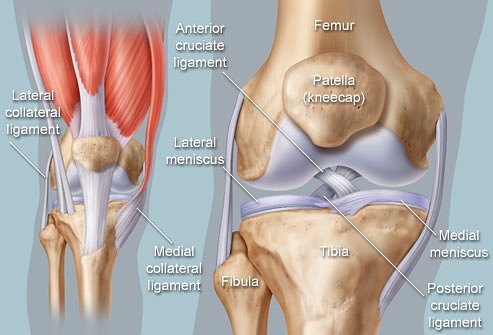Q: My knees took a beating when I played sports in my younger days. Now I just want to ride my motorcycle without knee pain. Suggestions?
Lots of us have had a prior knee injury. Sometimes, that injury has lasting effects on how we move and ride. Understanding how to minimize the impact your injury will have on your riding hinges on understanding how your knee works before it gets injured. You knee is indeed a stressed member of your frame since humans are built to bear the load and the stress of that load in an up-and-down (axial load), side-to-side (lateral stress), and round-and-round (rotational) fashion. Lets see what that all means.
Dr. Kaplan is a physician who rides. Got a medical question related to motorcycling? Send it to commontread@revzilla.com and put "Ask the Doc" in the subject line.
Important knee parts

Injuries
In general, the more parts you injure, the worse the injury and the longer it will take to recover. Remember that we have not discussed the muscle anchors (tendons) or the blood vessels and nerves that keep all of this alive, so opportunity for injury abounds! Once you injure your joint, it is never really normal and post-injury arthritis is quite common. Injuries occur in a variety of ways including:
- Crush (think leg trapped between car and your engine)
- Impact (think shin bone against your peg)
- Rotation (one part rotates around the other)
- Distraction (top and bottom get pulled apart)
- Combination of the above
- Overuse (too many squats with heavy weight when you were younger and in better shape)
What does this mean for the motorcyclist?
Injury means inflammation. Inflammation is part of the normal healing process but it also can cause pain. While most injuries heal pretty well (assuming that parts get reconnected and are well aligned), non-healing or poorly healing injuries are complicated and merit a separate discussion with your surgeon.
In general, isolated bony fractures do not impede pleasure riding or even most competition riding, because when the bones heal (assuming they are well aligned) they are really very strong and can handle the load placed on them. The joint space, on the other hand, is a different story.
Cartilage should be smooth and keep your bony ends gliding across one another. After injury, repeated wear across a surface that is not as smooth as it used to be leads to arthritis and inflammation. Inflammation increases the volume of joint fluid, making the joint feel tight and often leads to a swollen knee that does not flex or extend well. This may make you less comfortable in a typical sport riding position than in a more upright cruiser position. Anything that bounces your weight up and down across your knee joint, such as during off-road riding, can drive the bones and the cartilage against one another, leading to repeated injury. Pieces of cartilage can chip off and float in the joint (called joint mice, since they get everywhere). Joint mice create pain and can even lock your knee joint — a bit dangerous while riding! These may need to be removed in the operating room to restore more normal function.
Ligament injury may result in some joint instability (like football players without their ACL) that may require no therapy at all or may require a stabilizing brace during strenuous activity. While superslab riding generally does not create rotational stress across the knee, off road riding does — in a big way — and it couples that stress with an axial load (standing on your pegs) combined with lateral stress from your weight shifting side to side. Understanding that you have had a ligament or cartilage injury may significantly influence your choice of riding style!
What might help?
At some point I have used all of these (and still use some):
- Pre-ride anti-inflammatory (like ibuprofen or a similar OTC pain reliever)
- Changing your riding position to reduce knee flexion
- Gel footbed cushions to dampen transmitted forces
- Post-ride knee ice to reduce inflammation (only 20 minutes per hour)
- Weight loss (if appropriate) to reduce non-riding knee stress
- Orthopedic surgeon evaluation for diagnosis and therapy (an injection of artificial lubricating fluid or surgery may right for you)
- Some swear by OTC joint supplements — and some swear at them — (take at your own risk) but the most popular are chondroitin sulfate, fish oil, and glucosamine
- Knee bracing to limit rotation (you might not need one so get diagnosed first)
If you have severe pain that makes you limp after riding, makes your knee swell, or is not relieved by OTC analgesics, you should see an orthopedic surgeon ASAP.
What works for you?








